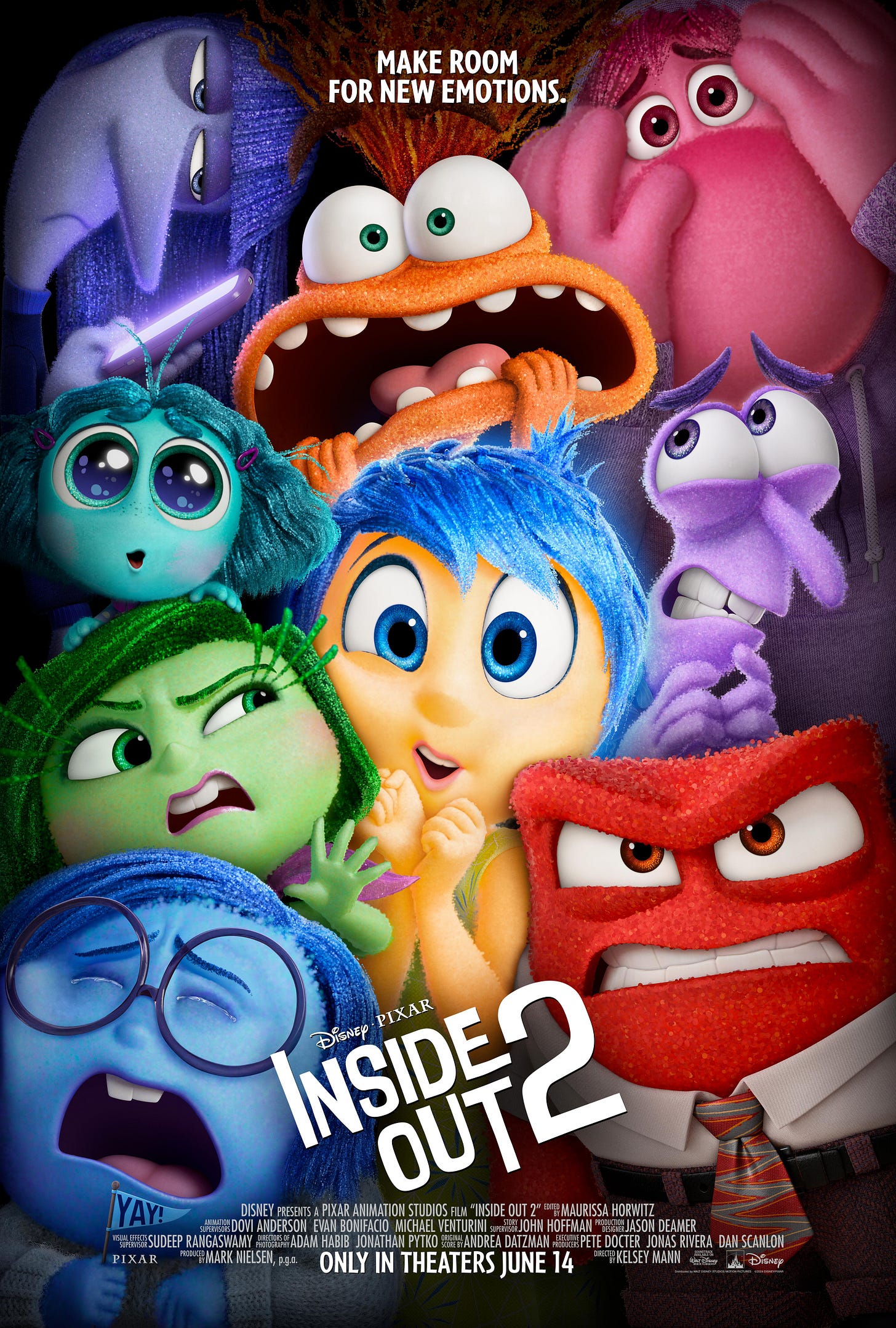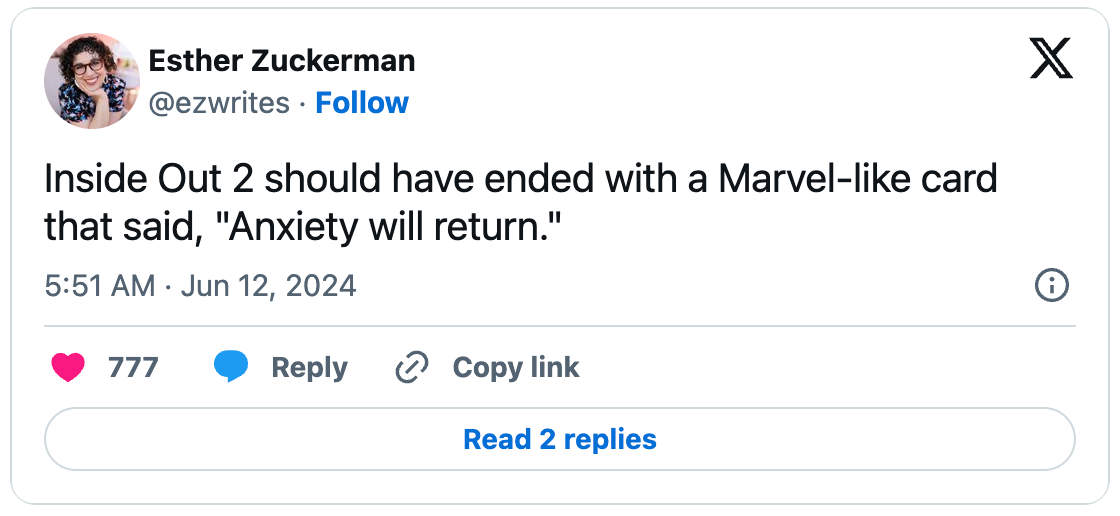Directed by Kelsey Mann
Language: English
Year: 2024
Shaun’s Rating: 3.2/5 ★
Before Watching:
I’ll admit that I was skeptical about more recycled IP. It seems that Disney is still getting it through their Mickey ears that their most successful ventures of the past couple decades have all been bold, original stories (Frozen, Encanto, Up, Tangled, Coco, etc.) instead of reused slosh. The obligatory 30 minutes of AMC trailers at this screening featured so many sequels and remakes that it was challenging to unearth any original thought—even the damn purple crayon book is getting an adaption starring the guy from Shazam. The first Inside Out film from 2015 was a shining triumph of Pixar’s originality and creativity, but I shuddered when I heard that two main actors have been replaced in the sequel.1 Yet—like Emmanuel Macron is saying this week—somehow things turned out… mostly fine?
Inside Out 2 brings back the five emotions we loved from the first movie (Sadness, Anger, Fear, Disgust, and their tireless leader Joy) to shepherd Riley through the next stage of young adult life. But, right before Riley departs for an important hockey camp, puberty (literally2) readjusts her mental console and heightens all of her emotional sensitivities. Before the brigade of emotions has time to readjust, a new group of adolescent pests crowds in, including Embarrassment, Envy, Ennui,3 and the over-controlling Anxiety. The voice cast of return pros like Amy Poehler, Lewis Black, and Phyllis Smith4 is joined by a new crop of talent, namely Tony Hale, Adèle Exarchopoulos, Ayo Edebiri, and Maya Hawke. I mean, have you seen Veep and The Bear? If I had that troupe of voices in my head, I’d be bullying my way through the eighth grade hockey rink like Logan Roy. You can’t convince me that a tweenage girl with Lewis Black behind the wheel isn’t the most devastating adversary imaginable.
Luckily, the film actually makes sense as a sequel. Anybody who isn’t as ancient and mentally unsound as all three Presidential candidates likely remembers how confusing adolescence was, and Mann doesn’t shy away from depicting that tumult in a way that is unique and additive to the Inside Out universe (though not quite as daring as Turning Red). Nevertheless, if you’re expecting Joy Story 2 to match the brilliance and cohesion of the original, you might experience Disappointment grabbing the controls (voiced in the next installment, I assume, by my father).
Others are quick to extrapolate that Pixar is on the way out, from their recent box office flops to the woke mind virus or whatever Tucker Carlson is rambling about this week. Alison Wilmore writes in Vulture:
By the end of Inside Out 2, it’s the inner world that feels forced onto the outer story, turning Riley into someone who has to lurch according to its whims rather than lead the way in her own struggle through the tortures of being a new teenager. She’s more puppet than full character, though the forces pulling her strings aren’t a rainbow of talking emotions so much as they are a studio that’s lost its touch.
First they came for Mr. Potato Head, and I said nothing, because I didn’t think we needed a Toy Story 5… thanks, killjoy.
Ultimately, Inside Out 2’s beautiful score, sublime animation, and tender emotional revelations stand on the shoulders of a brilliant construct. These assets don’t fully offset the film’s frantic pacing and undisciplined plot, but hey—call me Fergie, cause I’ve gotta feeling that white moms will still love it anyway.
Inside Out 2 premiered in Los Angeles and is now available in theaters worldwide.
After Watching:
Perhaps the most welcome addition to the studio’s lore of the young mind is a burgeoning “sense of self,” which allows Riley (Good Girl Gone Sad?) to face decisions with the reference of a moral framework. This illustration—while perhaps copying Avatar in its “Tree of Life” aesthetic—underscores a key theme of the franchise, that you need to accept the good with the bad.5 The film’s climactic depiction of an anxiety attack beautifully sells this point; what’s more Disney than preaching Hakuna Matata?
Riley’s deep dark secret is definitely that she’s a lesbian, but I’ll let that go. Disney is still calibrating how much queer coding they can add while still releasing films in the Middle East. I’m also ignoring the post-credits scene. I’m more disappointed that they introduced the deep dark secret character only for it to never materialize again, in perhaps the strangest sequence of the film. Most of Mann’s other quips (the “brainstorm”, the sar-chasm, the parade of future careers that features an ethnomusicologist) land better.
Inside Out 2 is a Pixar6 film, but it plays like the intended audience is older than their normal Gen-Alpha demographic—if you use the phrase “skibidi toilet rizz” unironically, this film will probably go over your head. Manohla Dargis reports in the New York Times:
For Pixar, every viewer (if especially grown-ups) is a would-be Anton Ego, the unhappy restaurant critic in “Ratatouille,” who, on tasting a delicious dish, flashes back to childhood when his mother tenderly served him the same food. That memory allows Ego to shed his preconceptions so that he can surrender to pleasure as he did once upon a time, much as Pixar insists that you to do while watching its movies.
I’m personally also hoping for a third installment where Riley’s adult emotions are led by Delulu.7
What’s Bill Hader up to instead now? Starring in another adaption, of course. 😮💨
Literally… metaphorically? Or literally, literally? Or just metaphorically, because the whole film is a metaphor?
Brilliant.
Phyllis (who won the voice acting Annie Award for her performance in Inside Out) actually came out of retirement to reprise her role, on the condition that they let her record from Missouri instead of trekking to LA.
Feel or No Feel?
Founded by George Lucas, if you can believe that. And when George Lucas was busy with his divorce, he sold it to Steve Jobs. Crazy, right?
Voiced, I assume, by Kanye.











